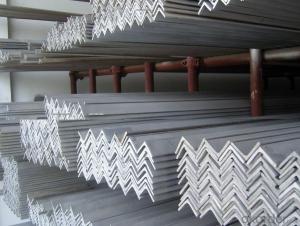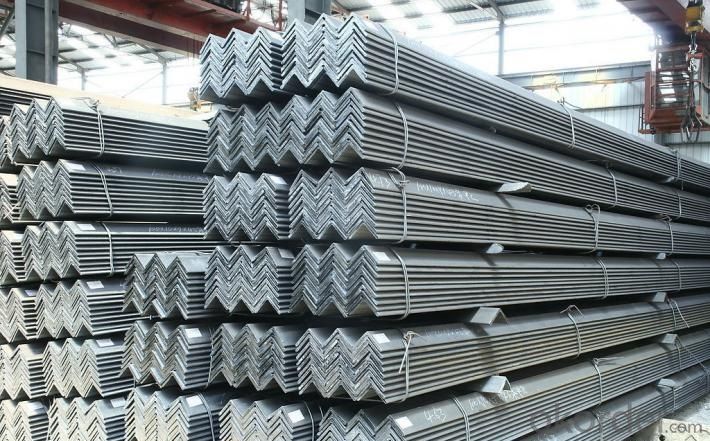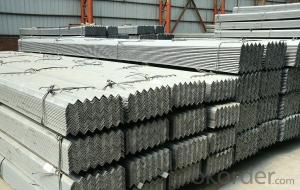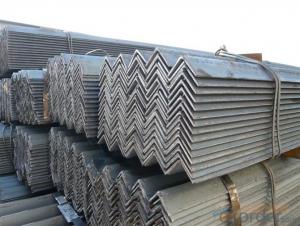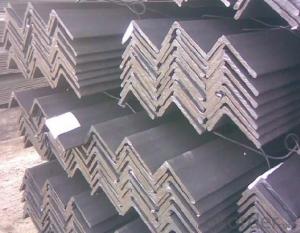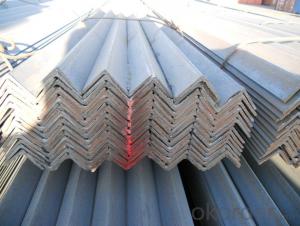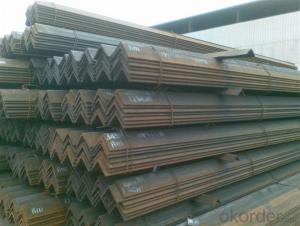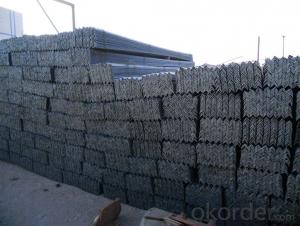GB Q345 Steel Angle with High Quality 80*80mm
- Loading Port:
- Tianjin
- Payment Terms:
- TT or LC
- Min Order Qty:
- 25 m.t
- Supply Capability:
- 10000 m.t/month
OKorder Service Pledge
OKorder Financial Service
You Might Also Like
Specifications of GB Q345 Steel Angle with High Quality 80*80mm:
1.Standards: GB
2.Material: Q345 or Equivalent
3.Length: 6m, 12m
4.Size:
| Size (mm) | Mass (kg/m) | Size (mm) | Mass (kg/m) |
| 80*80*6 | 7.376 | 80*80*8 | 9.658 |
| 80*80*7 | 8.525 |
Usage & Applications of GB Q345 Steel Angle with High Quality 80*80mm:
Trusses;
Transmission towers;
Telecommunication towers;
Bracing for general structures;
Stiffeners in structural use.
Packaging & Delivery of GB Q345 Steel Angle with High Quality 80*80mm:
1. Transportation: the goods are delivered by truck from mill to loading port, the maximum quantity can be loaded is around 40MTs by each truck. If the order quantity cannot reach the full truck loaded, the transportation cost per ton will be little higher than full load.
2. With bundles and load in 20 feet/40 feet container, or by bulk cargo, also we could do as customer's request.
3. Marks:
Color mark: There will be color marking on both end of the bundle for the cargo delivered by bulk vessel. That makes it easily to distinguish at the destination port.
Tag mark: There will be tag mark tied up on the bundles. The information usually including supplier logo and name, product name, made in China, shipping marks and other information request by the customer.
If loading by container the marking is not needed, but we will prepare it as customers' request.
FAQ:
Q1: Why buy Materials & Equipment from OKorder.com?
A1: All products offered byOKorder.com are carefully selected from China's most reliable manufacturing enterprises. Through its ISO certifications, OKorder.com adheres to the highest standards and a commitment to supply chain safety and customer satisfaction.
Q2: How do we guarantee the quality of our products?
A2: We have established an advanced quality management system which conducts strict quality tests at every step, from raw materials to the final product. At the same time, we provide extensive follow-up service assurances as required.
Q3: How soon can we receive the product after purchase?
A3: Within three days of placing an order, we will arrange production. The shipping date is dependent upon the quatity, how many sizes you want and the plan of production, but is typically 30 to 45 days from the beginning of production.
Images of GB Q345 Steel Angle with High Quality 80*80mm:


*If you would like to get our price, please inform us the size, standard/material and quantity. Thank you very much for your attention.
- Q: Bearing capacity of angle steel and channel steel
- According to the channel shape and can be divided into 4 kinds: cold bending equilateral channels, cold-formed non equilateral channel steel, cold rolled edge channels, the cold bending edge channels.According to the theory of steel structure, it should be stressed by the channel plate, that is to say, the channel should stand rather than lie prone.
- Q: How do you prevent warping of steel angles during fabrication?
- To prevent warping of steel angles during fabrication, there are several key measures that can be taken: 1. Proper material handling: Steel angles should be stored, transported, and handled carefully to avoid any bending or warping. They should be stored on a flat surface or rack, ensuring that they are not subjected to excessive pressure or force that could cause deformation. 2. Controlled heating and cooling: During fabrication processes that involve heat, such as welding or cutting, it is crucial to control the temperature and minimize the heat input. Rapid heating or cooling can lead to thermal expansion or contraction, causing warping. Proper preheating and controlled cooling methods, such as using heat sinks or heat-treating processes, should be employed to mitigate the risk of warping. 3. Proper welding techniques: Welding is a critical step in steel fabrication, and improper techniques can contribute to warping. It is essential to use appropriate welding parameters, such as correct amperage, voltage, and travel speed, to ensure a balanced heat distribution across the workpiece. Additionally, employing welding fixtures, clamps, or jigs can help hold the steel angles in place during welding, minimizing distortion. 4. Minimize stress concentration: Sharp corners or abrupt changes in geometry can create stress concentration points, which are prone to warping. It is advisable to avoid sharp corners by using radii or chamfers, which distribute stress more evenly. Furthermore, proper alignment and fit-up of the steel angles before welding can reduce residual stress and potential warping. 5. Post-welding treatments: After welding, it is essential to relieve residual stresses in the steel angles. This can be achieved through post-weld heat treatment or stress-relieving processes, such as annealing or normalizing. These treatments help to reduce internal stresses and minimize the risk of warping. Overall, a combination of proper material handling, controlled heating and cooling, appropriate welding techniques, stress minimization, and post-welding treatments can significantly contribute to preventing warping during the fabrication of steel angles.
- Q: What are the standard lengths of steel angles?
- The standard lengths of steel angles vary depending on the manufacturer and specific application, but common lengths range from 20 feet to 40 feet.
- Q: What are the standard dimensions for unequal leg steel angles?
- The standard dimensions for unequal leg steel angles can vary depending on the specific requirements of a project or the country in which they are being used. However, there are generally accepted standard dimensions that are commonly used in various industries. In the United States, the standard dimensions for unequal leg steel angles are typically defined by the American Society for Testing and Materials (ASTM). According to ASTM A6/A6M, the standard specification for general requirements for rolled structural steel bars, plates, shapes, and sheet piling, unequal leg steel angles are designated by their nominal size and weight per foot. For example, a commonly used unequal leg steel angle would have a nominal size of 2 x 1-1/2 inches and a weight per foot of 2.71 pounds. Another common size would be 3 x 2 inches with a weight per foot of 4.23 pounds. These dimensions may vary depending on the specific requirements of a project, but they serve as a general guide for the standard dimensions of unequal leg steel angles.
- Q: Can steel angles be used for support beams?
- Yes, steel angles can be used for support beams. Steel angles are often used in construction as support beams due to their strength, durability, and ability to bear heavy loads. They provide structural support and are commonly used in framing, bracing, and reinforcing various types of structures.
- Q: Are steel angles resistant to corrosion?
- Generally, steel angles exhibit resistance to corrosion. Typically, steel angles are manufactured from carbon steel or stainless steel, both of which possess inherent properties that resist corrosion. Carbon steel angles develop a protective layer of iron oxide, commonly known as rust, when exposed to oxygen and moisture. This rust layer acts as a barrier, preventing further corrosion of the underlying metal. Conversely, stainless steel angles contain at least 10.5% chromium, which results in the formation of a thin, transparent oxide layer on the surface. This oxide layer, referred to as a passive film, offers exceptional corrosion resistance, making stainless steel angles highly resistant to rust and other forms of corrosion. Nevertheless, it is essential to acknowledge that steel angles can still corrode under specific conditions, such as prolonged exposure to high levels of moisture or corrosive chemicals. To enhance the corrosion resistance and prolong the lifespan of steel angles, regular maintenance and proper cleaning are imperative.
- Q: Are steel angles resistant to high winds?
- Yes, steel angles are generally resistant to high winds due to their robust structure and strength. They are commonly used in construction and engineering projects to provide stability and support against strong winds.
- Q: What is the difference between hot-rolled and cold-rolled steel angles?
- Hot-rolled and cold-rolled steel angles refer to two different manufacturing processes used to create steel angles with varying characteristics. Hot-rolled steel angles are produced by heating a steel billet or ingot to a high temperature and then passing it through a series of rollers. This process allows for the metal to be shaped and formed while it is still in a malleable and pliable state. As a result, hot-rolled steel angles tend to have a rougher surface finish and less precise dimensions compared to cold-rolled angles. However, they are generally stronger and more durable, making them suitable for structural applications that require high strength and load-bearing capacity. On the other hand, cold-rolled steel angles are created by passing hot-rolled steel through a series of rollers at room temperature. This process not only helps to refine the dimensions and surface finish of the steel angles but also increases their strength and hardness. Cold-rolled angles have a smoother surface finish and more accurate dimensions, which makes them ideal for applications that require a precise fit or a smoother appearance. They are commonly used in architectural and decorative applications, as well as in industries where aesthetics and precision are important. In summary, the main differences between hot-rolled and cold-rolled steel angles lie in their manufacturing processes, surface finish, dimensional accuracy, and applications. Hot-rolled angles are stronger and rougher, suitable for structural purposes, while cold-rolled angles have a smoother finish and precise dimensions, making them more suitable for decorative and architectural applications.
- Q: Can steel angles be used in overhead crane or hoist systems?
- Indeed, overhead crane or hoist systems can indeed utilize steel angles. These structural components find widespread application in the construction of crane runways, support structures, and trolley rails. By furnishing a robust and inflexible framework for the crane or hoist system, steel angles prove their worth. Notably, their superior strength-to-weight ratio renders them an optimal selection for heavy-duty tasks. Furthermore, the convenience of welding or bolting steel angles together facilitates effortless installation and customization. All in all, steel angles offer a dependable and economically viable choice for integration into overhead crane or hoist systems.
- Q: Can steel angles be used as a support for shelving?
- Indeed, steel angles have the capacity to serve as a reliable support for shelving. With their robustness and durability, steel angles offer exceptional support for shelves. They are frequently employed in industrial environments and demanding scenarios that necessitate a sturdy and steady shelving system. Steel angles can effortlessly be affixed to walls or other structures to establish a framework for shelves or can be utilized as brackets to directly uphold the shelves. Given their solid construction and ability to bear heavy loads, steel angles prove themselves as a dependable choice for supporting shelving units.
Send your message to us
GB Q345 Steel Angle with High Quality 80*80mm
- Loading Port:
- Tianjin
- Payment Terms:
- TT or LC
- Min Order Qty:
- 25 m.t
- Supply Capability:
- 10000 m.t/month
OKorder Service Pledge
OKorder Financial Service
Similar products
Hot products
Hot Searches
Related keywords
